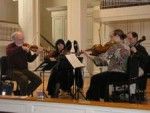Lydians in Harmony: LSQ Plays at Colgate

In my four years at Colgate, I’ve come to the conclusion that Colgate University has an abnormal obsession with string quartets. I find myself reviewing the second string quartet of the semester, the Lydian String Quartet (LSQ), who performed on Sunday in the Chapel, and have yet another string concert slated for next weekend. What is this fixation with string instruments, both here at Colgate and in the 500-year history of post-Renaissance Western music? While I still haven’t totally figured out the answer to this vexing question, Sunday’s concert offered one hitherto-ignored possibility: the felicity with which string instruments can be employed to play vastly different musical styles. After listening to the LSQ’s program of Beethoven, Gabriela Frank and Mozart, I couldn’t help but be impressed by the way the performers successfully coaxed three disparate types of music from their instruments.
The LSQ chose to open their concert with a work of Beethoven, “String Quartet no. 10 in Eb major, op. 74,” nicknamed “The Harp.” When I first read the biography of the Lydians, I was struck by the fact that they were a group strongly dedicated to supporting new music (why would they choose to begin with a relatively classic work?). After listening to but a few minutes of the opening Poco Adagio – Allegro, however, I realized I should kick my stupid music major butt for my foolishness. Beethoven is known for being a bit of a musical rebel and forward thinker, and this quartet is no different. In a break with common sonata form, the quartet begins with an adagio section before transitioning into a movement packed with pizzicato arpeggios. The novelty of these arpeggios in particular (also the impetus for the quartet’s being named after a harp) was masterfully emphasized by the dainty plucking of the LSQ players.
This keen sense of expression was likewise demonstrated in the Presto movement, which featured rapid alterations between fierce tremolos in the lower voices and a soaring, mellifluous violin line. I credit first violinist Daniel Stepner for expertly coloring this part, and indeed all of the other works performed on Sunday; while all the Lydians played with emotion, his was the most convincing performance. Finally, no mention of Beethoven’s emotional pull would be complete without mentioning his trademark rapid changes in dynamics; the LSQ’s dramatic crescendi nearly knocked me out of my chair a few times.
Following the final Allegro molto of Beethoven’s quartet (for the most part disappointingly average compared to the other movements), the LSQ moved in a whole different direction by performing Frank’s “Leyendas: An Andean Walkabout.” This composition was inspired by the composer’s mixed heritage (including American, Lithuanian, Jewish and Chinese descent) and works in ethnomusicology, and it attempted to blend Peruvian with Western musical styles. I’ll admit now that while I didn’t enjoy much of the piece (especially the dissonant rubbish of the middle movements), it was nevertheless interesting; Frank called for the Lydians to replicate some strange sounds of traditional Andean instruments on their strings.
This process had its flaws, especially because no matter how high or squeaky a violin plays, it just does not sound like a flute. Regardless, the exotic harmonic structure and part-writing (a.k.a. catchy musical lines) in the “Toyos” and “Tarqueada” movements were convincing enough to evoke images of South America (even if some of the images were ornery llamas). My skepticism disappeared, however, when the group played the final two movements, characterizing professional mourners hired for funerals and flirtatious young men respectively; I was duly impressed at the LSQ’s ability to magically conjure up mental images of these personalities. In the case of the mourners it was easy (here’s an easy musical equation to remember: more dissonance equals more pathos), but the romantic melody and lower voices mimicking a “storm of guitars” in the love song really won me over. By the time the strumming came to a close I was actually disappointed that I would have to leave the lusty “romanceros” behind (though I suspect that if they had been around, they wouldn’t have minded exchanging me for some lovely nearby damsel).
Following an extended intermission, the LSQ (along with guest violist and Professor of Music Laura Klugherz) returned to play by far the most classical piece of the concert, Mozart’s “Quintet in g minor, K.516.” While the previous pieces were full of emotion (of a variable character) and were overall movingly performed by the Lydians, this Mozart quintet had an entirely different feel to it. While there was a great deal of pathos in the first half, Mozart chose to resolve the piece with a lighthearted vaunt into G major at the end. Many critics question the wisdom of ending the quintet on such a joyous note (I’m not one of them though; I enjoy my music, just like my movies, sappy and full of happy endings), but the Lydians transitioned between the two disparate moods magnificently.
The third movement, an Adagio ma non troppo, was the turning point and the LSQ did a wonderful job of evoking both the sorrow of the previous “Allegro” and “Menuetto” while simultaneously hinting of the joy to come in the closing “Adagio-Allegro.” My only concern with this piece lay in it’s relation to the rest of the program; I never thought I’d say this, but after the previous works Mozart sounded a bit too tame and refined for the concert.
In their ambitious and varied program, the Lydians forced concertgoers to open their minds to a whole range of musical possibilities. And, while not every moment was orally pleasing, no one in the audience left the concert doubting the skill or the enthusiasm of the LSQ.? I can only hope that the remainder of the string concerts, which I’ll undoubtedly be exposed to this semester, are as thought-provoking.






